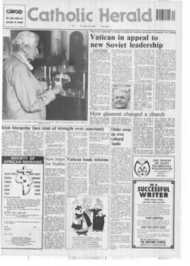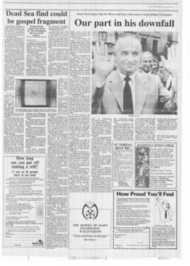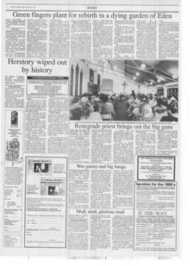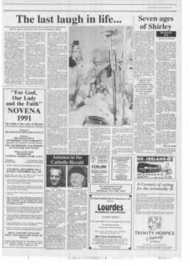Page 5, 23rd August 1991
Page 5

Report an error
Noticed an error on this page?If you've noticed an error in this article please click here to report it.
Tags
Share
Related articles
Turin Shroud Could Be Genuine
Oxford Shroud Leak Rejected
Clear View For Vatican
Rome Charged With Monitoring Liberation Theology At Synod
Dead Sea Discovery
Dead Sea find could be gospel fragment
Viviane Hewitt reports from Rome on "the archeological discovery of the century"
A SCIENTIFIC symposium in October in Bavaria will force one of the Vatican's best kept secrets out into the open. It is known as the "7Q5" and it could represent the archaeological discovery of the century for Christians and non-Christians alike.
The 7Q5 is a tiny fragment of parchment about the size of a one pound coin. It bears 20 letters in Greek spread over five lines and for the past 20 years highly specialised laboratories all over the world have been quietly subjecting it to tests. One conclusion, although may do not agree, is that the fragment reads: "... because they had not seen what the miracles of the loaves meant; their minds were closed. Having made the crossing, they came to land at Gennesaret and moored there. When..."
After a decade of pouring over the Old Testament for the phrase, some scientists have concluded that the 7Q5 is none other than a New Testament passage from the gospel according to St Mark 6, 52-53.
Furthermore, they have backdated it to no later than the year 50, defying even the general consensus of opinion among Vatican experts that the synoptic gospels were written between the years 70 and 100.
T h e possibility, however, that thc7Q5 represents a
virtual eye witness account of an episode in the life of Christ, has been kept under tight Vatican wraps since 1971,when a Spanish-born Jesuit, Fr Jose O'Callaghan, first announced the "discovery" The paradoxical fear is that "the less we know about the historical Christ, the more faith we will have in him", said a German-born professor, Carsten Pieter Thiecle, one of the scientists whose research is only now forcing exegetic academics and theologians to reconsider their studies so far into the origins of the New Testament.
The 7Q5 fragment was found in grottoes near the Dead Sea at Qumran where the Dead Sea Scrolls were uncovered in 1947. Although it was in Greek, unlike the others which were written in Hebrew and Aramaic, it was also presumed to bear an Old Testament phrase. For two of the other fragments which turned up at the same time were found to represent Exodus 28, 4-7 and
Baruch 6, 53-54.
It was not until 1971 that Fr O'Callaghan, a papyrologist and professor at the Pontifical Biblical Institute in Rome decided to reexamine the unidentified fragment number five, uncovered in the grotto archaeologists had called number seven.
A clearly visible sequence of letters on the fourth line nnes seemed to suggest the word egennesen which means "generate" but Fr O'Callaghan could find no passage in the Old Testament to match up. So he turned to the New Testament and located it in Sr Mark's gospel.
When Fr O'Callaghan announced his discovery, Rome's Biblical Institute was cautious. The then institute director, Jesuit Carlo Maria Martini, now the Cardinal Archbishop of Milan,
commented on the identification of the 705 fragment with St Mark in the Jesuit review La Civilta Cattolica.
"The casual matching of just a few letters spread out overdifferent lines with a well known literary text is rather improbable", he wrote.
He nevertheless ordered a full examination of O'Callaghan's claim for, according to one church archaelogist who had worked on the Holy Land finds, Paul V1 was convinced of the authenticity of the 7Q5 fragment.
"I remember that Paul VI heard about the find and it is said that he wanted to make an official announcement to the world but he was dissuaded from doing so", said archaeologist, Fr Michele Piccirillo.
The Pope's counsellors warned him that a pontifical announcement could compromise the church since O'Callaghan's claim had still not been subject to thorough scientific scrutiny.
"I must admit that, I too, would have been cautious," said Fr O'Callaghan, dean of the Pontifical Institute's Biblical Faculty where he has been teaching for 24 years and the author of over 200 works. But he was not prepared for the general silence that would greet the results of the scientific scrutiny going a long way to proving him right.
In one of the most recent, in a laboratory in Oxford, the 7Q5 text was compared with numerous examples of GreekChristian literature but the computers continued to identify the fragment with the gospel according to St Mark, chapter 6, 52-53.
Ironically, the O'Callaghan "discovery" has found its most fervent supporters in Protestantism. First to break the silence shrouding the 7Q5 was the German Lutheran scientist, Professor Thiede, 38, who has recently completed his own series of tests.
e published his findings in an in-depth study, The Oldest Manuscript of the Gospels, which even the Biblical Institute in Rome has now published.
In it he concludes"on the basis of the rules of paleographical research, it is certain that the 7Q5 is Mark 6, 52-53, the oldest fragment we have of a New Testament text, written at about 50 AD.
"When O'Callaghan first made his find known, no one believed that the gospel of Mark could have been written so early on and that Christian texts could have been found at Qumran. Even those who accepted that, from a papyrological point of view the discovery had been made after sound research, were sceptical about it", he said.
Another Protestant-born expert who supports O'Callaghan's theory is 78-year-old Harald Riesenfeld, the Professor Emeritus of New Testament Studies at the University of Upsalla in Sweden who converted to Catholicism seven years ago.
He admits that academics and theologians have been reluctant to consider the possibility of the 7Q5's authenticity and warns: "we should not think that today's crisis of faith can be resolved by back-dating the gospels. Acceptance of the gospel message is as much an act of faith today as it was then and the degree of credibility of the gospels does not bring about acceptance. Backdating would, however, leave much less room for manipulation of the figure of Christ".
In their book, The First New Testament, two Presbyterian professors praised Pr O'Callaghan for challenging the efforts of widely esteemed scientists and the theological theories that were taken for granted.
But French theologian, Pierre Grelot, a former member of the Pontifical Biblical Commission, has described the O'Callaghan theory as "ridiculous".
"There is a tendency to push strongly for an earlier date for the gospels because otherwise there would be no eye-witnesses to prove that the events really happened. Fear is behind this", he said.
Beyond the theological arena, an independent study by German Professor Ferdinand Rohrhirsch with no religious axe to grind also found in favour of O'Callaghan.
In Mark in Qumran? published last year, Professor Rohrhirsch examines t!if. methodological precision both
behind O'Callaghan's "discovery" and the series of tests disproving it.
"The result was that by the time my research was completed, O'Callaghan's hypothesis was still standing while all the rejections of it proved to be inconsistent or imprecise to the extent that one renowned scholar had neglected to insert an elementary detail in the computer during tests and this prejudiced his whole critical construction", Rohrhirsch said.
In October at long last, they will all cross swords at the symposium in Bavaria organised by the Catholic University of Eichstactt. And will the spotlight be trained only on the tiny 7Q5 fragment or on the whole historical structure of the New Testament and the memoirs of the first converts?
blog comments powered by Disqus











